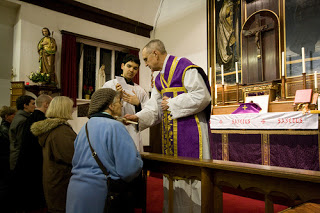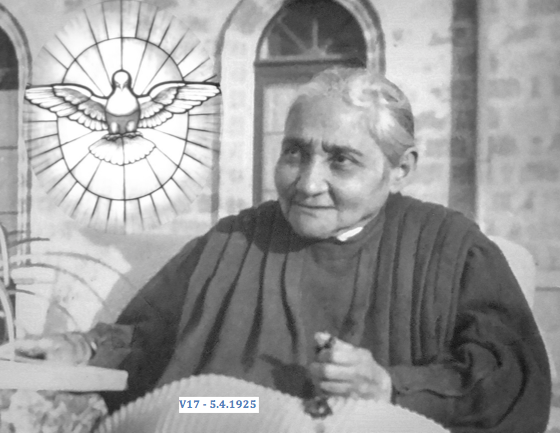 A priest blesses parishioners’ throats on the Feast of St. Blaise
A priest blesses parishioners’ throats on the Feast of St. Blaise
***
Hours of the Passion
Twenty-second Hour: From 2 to 3 PM
Fifth Word on the Cross
O my dying Crucified, clinging to the Cross, I (the Servant of God Luisa Piccarreta) feel the Fire that Burns all of Your Most Holy Person. Your Heart beats so strongly that, pushing out Your ribs, it torments You in such a harrowing and horrible way, that all Your Most Holy Humanity undergoes a transformation that renders You unrecognizable. The Love that Enflames Your Heart withers You and Burns You completely; and You, unable to contain it, feel the intense torment, not only of the corporal thirst, but of the shedding of all Your Blood—and even more, of the ardent thirst for the salvation of our souls. You (Our Lord Jesus Christ) would want to drink us like water, in order to place us all in safety within Yourself; therefore, gathering Your weakened strengths, You cry out, “I thirst.” Ah, You repeat this voice to every heart, “I thirst for your will, for your affections, for your desires, for your love. A water fresher and sweeter than your soul you could not give Me. O please, do not let Me Burn. My thirst is ardent, such that I not only feel My tongue and My throat Burn, to the point that I can no longer utter a Word, but I also feel My Heart and bowels wither. Have pity on My thirst—have pity!” And as though delirious from the great thirst, You abandon Yourself to the Will of the Father.
***
Blaise of Sebaste
Also known as Blase, Blasien, Biagio; Died c. 316.
Many Catholics might remember Saint Blaise’s feast day, February 3, because of the Blessing of the Throats that take place on this day. Two candles are blessed, held slightly open, and pressed against the throat as the blessing is said.
Very few facts are known about Saint Blaise. It is believed he was a bishop of Sebastea in Armenia who was martyred under the reign of Licinius in the early fourth century.
The legend of St. Blaise tells us that he was born into a rich and noble family who raised him as a Christian. He became a bishop. Later, a new persecution of Christians began. He received a message from God to go into the hills to escape persecution. Hunters discovered a cave surrounded by wild animals who were sick. Blaise walked among them unafraid, curing them of their illnesses. The hunters recognized Blaise as a Bishop, so they captured him to take him back for trial. On the way back, he talked a wolf into releasing a pig that belonged to a poor woman. When Blaise was sentenced to be starved to death, the woman, in gratitude, sneaked into the prison with food and candles. Finally, the governor had Blaise killed.
Saint Blase is the patron of physicians, sick cattle, wax-chandlers, woolcombers, and of wild animals because of his care for them and of those with throat maladies. He is invoked against afflictions of the throat (Bentley, Roeder).
As one of the Fourteen Holy Helpers, Saint Blase was much venerated throughout Central Europe. In art he is a bishop with a metal comb and a tall candle.
Read more on St. Blaise, click here

